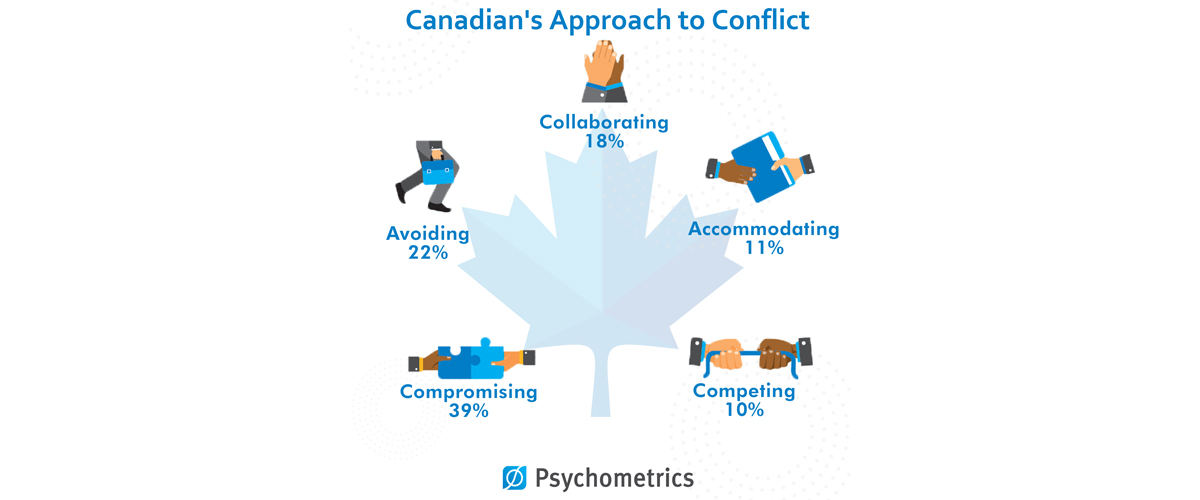
The Canadian Way: Our approach to decisions
25 June 2019
growthzone
Canadians, eh? We’re always known as the polite and friendly country, with individuals quick to apologize even when wronged. How many of us have apologized to someone else who clearly bumped into us? Or even apologized to an inanimate object when we bumped into it? (You can be honest, I’m not judging.)
To better understand why Canadians are seen this way, I gathered the results of 41,750 Canadians who took the Thomas-Kilmann Conflict Mode Instrument. This instrument helps individuals and teams understand their approach to conflict. It suggests that conflict itself isn’t necessarily a bad thing (only when used ineffectively), and that each approach to conflict has merit.
These approaches are the following:
Avoiding: You look to disengage from the conflict. A great approach for diffusing a heated situation.
Competing: You look to satisfy your needs, even if it’s at the expense of the needs of others. This is a great style for situations where a quick decision is required (such as in an emergency).
Accommodating: You look to satisfy the needs of others, even if it comes at the expense of your own. This is a great approach when harmony needs to be maintained, or if you realize that your idea/approach is wrong.
Compromising: You look to satisfy everyone’s needs partially, as the solution means that no one is getting everything that they wanted.
This is a great approach for when you need to make a decision under a time pressure, or if the situation is too complex to come to a full agreement on.
Collaborating: You look to find a solution where everyone gets everything that they wanted. This is an ideal outcome, but is difficult to actually achieve.
In the image below, you’ll find the distribution of these 5 approaches to conflict, based on the style that individuals gravitate towards (i.e. that they reported using most frequently).
Based on the descriptions of the styles above, you may have expected that Accommodating would be the most frequent natural style for Canadians. However, it seems that there is purpose behind our polite demeanor. The majority of Canadians tend to take a Compromising approach to conflict, which means that they are willing to give up something that they are seeking in order for everyone to get something (but not everything) that they want. This style is very pragmatic (weighing the pros and cons) and less aggressive than the Competing style (making it a bit more diplomatic), but not as cooperative as the Accommodating style.
The Compromising style is useful when the parties involved in the conflict cannot agree on a win-win solution, so a workable middle-ground is necessary. This compromise can often act as a temporary solution until a better one can be developed. This approach to conflict is especially effective when a decision needs to be made quickly, or the situation is too complex to develop an effective win-win solution. However, those who prefer to compromise may want to be careful that they are not agreeing to a compromise that does not meet their minimal needs in order to resolve the conflict quickly (i.e. settling short).
Instead of seeking the middle ground, is there a benefit to being more competitive? Those who have a Competing preference will try to resolve a conflict in a way where they get what they need, and there may be a lot of Canadians who are trading away something that they need, in order to create a compromise. As a whole, we may be missing opportunities where, if we pushed a little harder, we might have been able to gain a benefit that we could really use.
You might be most comfortable compromising when you encounter conflict, though that may not always be the best approach. The next time you encounter conflict, ask yourself the following questions:
- Is the situation simple (unidimensional) or complex (multi-dimensional)?
- Do we trust each other enough to be open about our needs and concerns?
- Does the environment allow us to share our needs and concerns?
- Do we communicate effectively with each other?
- How much time do we have to resolve this conflict?
- How important is the topic to me?
- How important is the topic to the other side?
- How important is our relationship?
Based on your answers to these questions, you can choose the approach that will provide the ideal outcome.
So, remember: You don’t have to apologize to the chair when you bump into it. It’s okay to focus on your throbbing toe instead.
Written by Justin Deonarine, I/O Psychologist
